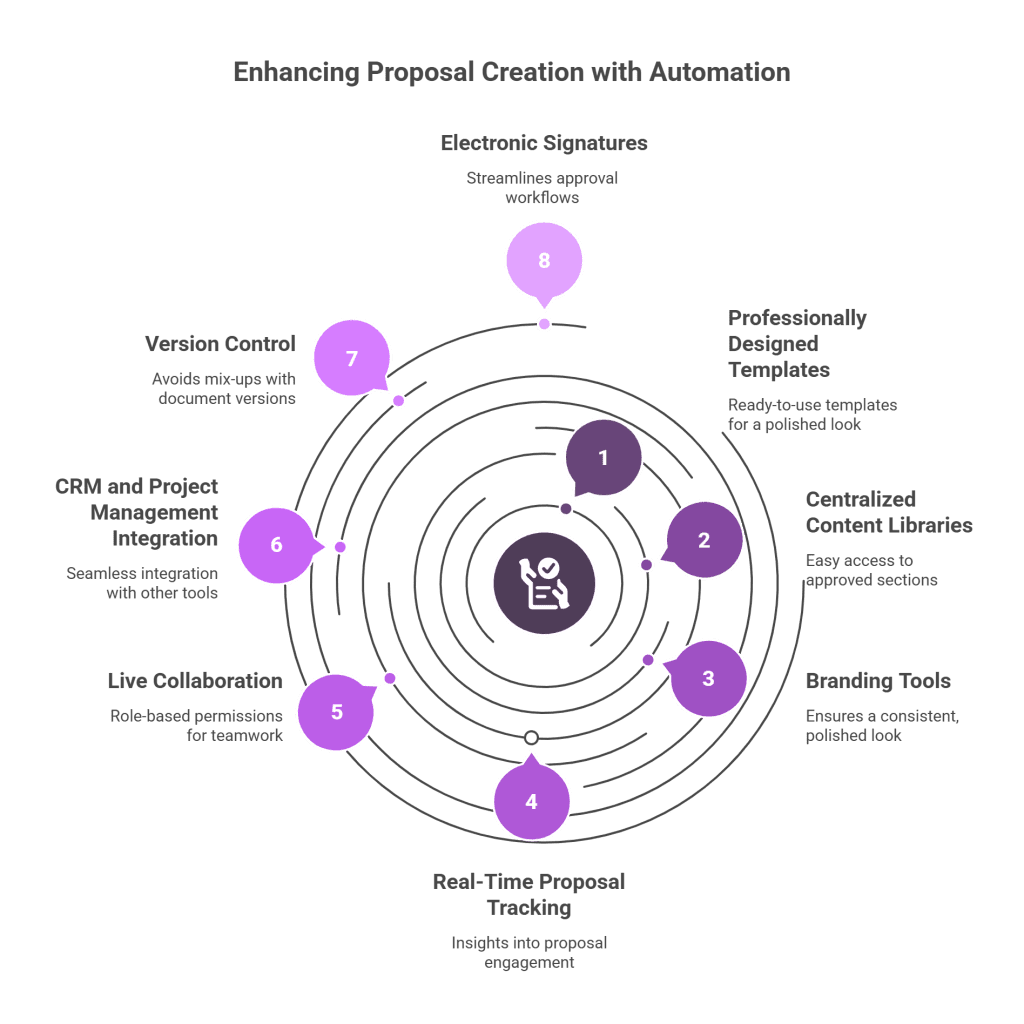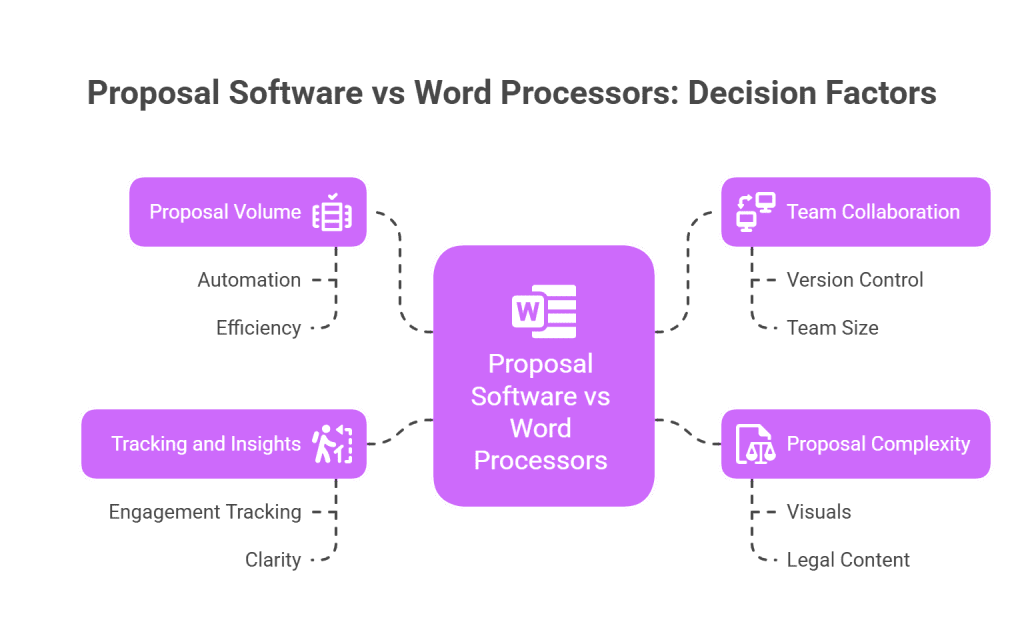You know those harmless debates in the office.. the kind where people argue whether sticky notes or fancy apps are better for to-do lists? This one feels exactly like that, except it’s about proposals, and the stakes are much higher. Much, much higher.
Everyone’s got an opinion. Some folks stick to MS Word and Google Docs like they’re family heirlooms. Others have a new tool suggestion ready before you even finish your morning coffee.
But proposals carry more weight than a simple document. They open doors, shape first impressions, and can often be the difference between winning business or losing it. And that’s precisely why the proposal software vs word processors debate deserves attention beyond convenience. The question here isn’t just about personal preference. It’s about what works better to create professional, accurate, and efficient proposals: proposal software or word processors?
Below is a compilation of what we’ve learned along the way and what businesses are figuring out too.
What Do We Mean by Proposal Software vs Word Processors?
Let’s start simple. Traditional word processors like MS Word or Google Docs are built for all kinds of writing. Reports, notes, essays, proposals, it’s all in there. Most of us have been using them for years. If your desktop is anything like mine used to be, it probably holds a folder full of recycled proposal files.
But a proposal software has a different focus. These tools exist for one purpose: building, managing, and sending proposals with structure and efficiency. They help with collaboration, branding, and often handle the tedious bits like version control or formatting.
If you’ve tried PandaDoc or Better Proposals, you’ve seen how proposal automation software simplifies the process. We’ve also seen teams experiment with AI-driven proposal creation. Some of those AI Proposal Generators can save time, though they work best when you know exactly what kind of proposal you want to produce.
Word Processors for Proposals: The Familiar Route
Most teams start with what they know. You open an old proposal, hit “Save As,” swap the client name, change a few numbers, and send it out.
It works, especially at first. But as proposal demands grow, the cracks show:
- Formatting starts slipping out of place
- Old, outdated content sneaks back in
- Collaboration turns into a confusing thread of emails
- Tracking proposal engagement feels impossible
Despite these issues, word processors remain the go-to for many teams because they feel familiar, require no extra setup, and let you build proposals however you like. But that freedom often comes at the cost of time, consistency, and oversight. And that is something to really think about.
What Features Does Proposal Software Bring to the Table?

So this is where it gets interesting and the proposal software vs word processors decision takes shape.
Proposal automation software brings order to what often feels like chaos. But beyond templates and convenience, let’s look at key features most modern proposal automation tools provide:
- Professionally designed templates, ready to use
- Centralized content libraries for easy access to approved sections
- Branding tools to ensure a consistent, polished look
- Real-time proposal tracking and engagement insights
- Live collaboration with role-based permissions
- Integration with CRMs and project management tools
- Version control to avoid mix-ups
- Electronic signatures and approval workflows
These proposal automation benefits help teams create professional, accurate proposals without the last-minute stress.
That being said, every proposal builder has its own sweet spot. Some focus heavily on design, while others lean into integrations or e-signatures. What we’ve noticed at Proposal.biz is that most teams don’t just want automation anymore. They want a tool that actually understands what they’re trying to get done. That’s why we’re building ours to make AI work for you, not the other way around. It’s less about adding features for the sake of it and more about letting the tool handle the parts that slow you down.
When We Knew It Was Time to Switch
In our initial years writing proposals, just like everyone else, we leaned on Google Docs like a safety blanket. It felt familiar until the day we lost a deal. The proposal had mismatched fonts, outdated numbers, and a legal clause that hadn’t been reviewed for months. The client noticed it all.
That moment pushed us toward proposal software. We are a software development company, we were excited to build and use software to solve our newest problem. Suddenly, proposals felt less like a gamble. They looked sharp, stayed consistent, and for the first time, we could track what happened after we sent them.
Why Proposal Automation Tools Are Gaining Ground
It’s not just personal stories. Businesses everywhere are leaning toward tools like Proposify, PandaDoc, and Better Proposals. In conversations with founders, we keep hearing the same thing: teams want to speed up drafting without sacrificing quality. That’s partly why using ChatGPT for proposal writing is becoming popular as a starting point.
Proposal automation software helps teams present polished proposals, keep branding intact, and track the entire proposal journey.
Industry reports show a growing preference for proposal automation, especially among businesses sending more than 10 proposals per month or handling complex, multi-stakeholder deals. The ability to track proposal engagement and reduce manual errors is quickly becoming the new standard.
When Word Processors Still Make Sense
While proposal software offers many advantages, traditional word processors still have their place. They work well when:
- You send very few proposals each month
- Your proposals are simple, without design needs
- You work solo and don’t need team collaboration
- You enjoy building every proposal from scratch
In small teams or early-stage businesses, the familiarity and simplicity of word processors might feel sufficient. But as proposal complexity increases or your team grows, sticking to word processors often slows things down.
Proposal Automation Benefits That Are Hard to Ignore
These proposal automation benefits can reshape your proposal process:
- Templates and reusable content speed things up
- Branding stays consistent without constant tweaks
- Errors are reduced with organized content
- Teams collaborate easily without version mix-ups
- Engagement tracking helps with confident follow-ups
- Legal and pricing content stays reliable and compliant
- Real-time analytics provide insight for continuous improvement
Proposal automation tools bring structure, efficiency, and a polished look to every proposal, giving your team more time to focus on strategy rather than formatting. The timing for better tools couldn’t be more fitting. Proposal software has come a long way from complicated setups and clunky templates. Today, it’s built with simplicity in mind. More teams are choosing these tools because they’re straightforward, quick to set up and take the guesswork out of sending professional proposals. It’s becoming less about wrestling with formatting and more about getting your ideas in front of the right people.
How to Choose: Which Approach Fits Your Business?

Der proposal software vs word processors decision depends on your unique needs. Here’s how to assess:
1. Proposal Volume
High-volume teams save time with automation.
2. Team Collaboration
Larger teams avoid version control issues with proposal software.
3. Proposal Complexity
Proposals with visuals, pricing tables, or legal content stay organized with automation.
4. Tracking and Insights
Proposal software tracks engagement, offering clarity. Word processors fall short here.
Figuring out which proposal format works best isn’t always straightforward. We’ve broken down the different types of business proposals based on what we’ve seen clients use most often.
What’s Next for Proposal Creation?
Proposal creation is changing fast. Teams that use proposal automation software are better prepared for evolving client expectations:
- AI tools help draft faster
- CRMs and payment tools integrate with ease
- Interactive, web-based proposals replace static PDFs
- Real-time data helps improve proposal strategy
Staying ahead means embracing tools that simplify the process while keeping proposals sharp and professional.
Our Experience and What to Consider
For our team, leaving word processors behind made the entire proposal process easier. Along with saving time, we stayed organized and confident. Proposals looked professional and tracked engagement clearly.
We’ve been looking closely at how businesses handle RFPs, and honestly, the gap between manual and automated responses is huge. If that’s on your radar, we broke down what works (and what doesn’t) with RFP automation.
Der proposal software vs Word processors decision depends on your goals. Both have their place, but automation offers clarity, structure, and peace of mind.
At Proposal.biz, we’re building a proposal automation tool designed for real business challenges. It’s shaped by everyday proposal experiences and made to simplify your process.
If you want to create proposals that reflect your best work, save time, and stay organized, keep an eye on what we’re building.